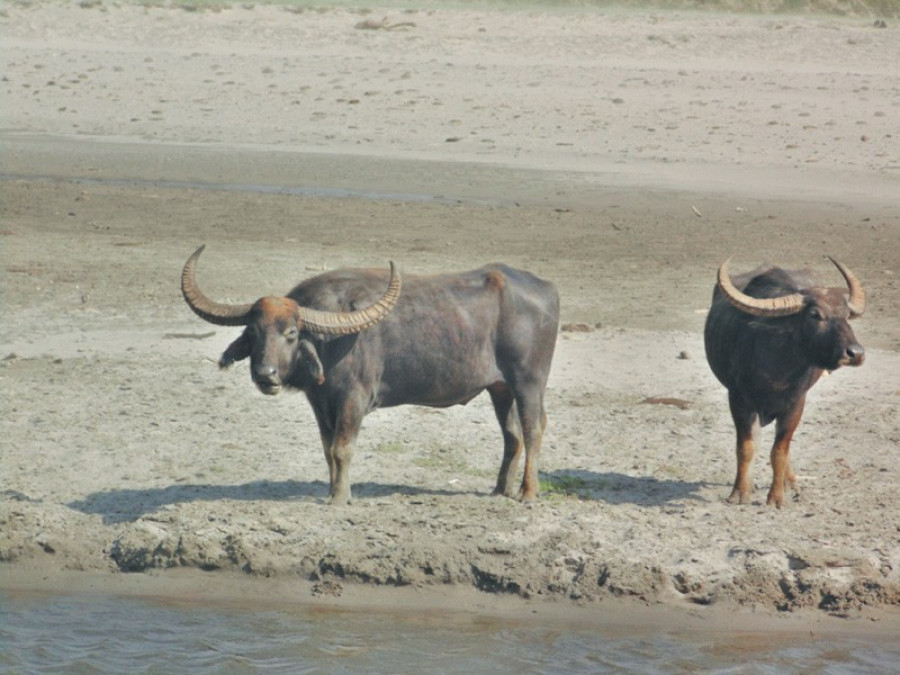Climate & Environment
New census shows wild buffalo numbers up 13 percent at Koshi Tappu
The protected park has seen an increase in wild water buffaloes in recent years, however, retaliatory killings remain a challenge for conserving the endangered species.
Chandan Kumar Mandal
The number of wild water buffaloes inside the Koshi Tappu Wildlife Reserve has reached 498, according to the latest count. The figure is 13 percent higher than the previous count. Wild water buffaloes, known as Arna in Nepali, are endangered species.
The new census found 57 more water buffaloes at the reserve compared to the previous census of 2018, which had recorded their numbers at 441. Before that, in 2016, their population stood at 433.
“The rise in Arna population is an encouraging development for the park. A growth of 13 percent in three years is significant,” said Ashok Kumar Ram, chief conservation officer at the Koshi Tappu Wildlife Reserve, which is the only natural habitat for Arna (Bubalus arnee) in the country. “The latest increase can be attributed to improved habitat, regular patrolling by park guards and increased surveillance. With adequate food and water, their number can be increased.”
According to the data provided by the park, there are currently 221 adult male wild buffaloes, 162 adult female wild buffaloes, 48 half-adult wild buffaloes, 35 two-years calves and 32 calves below one year. The counting had begun on April 19 and concluded on Sunday [April 25].
Arna is placed among endangered species—there are just 3,400 of them in the world—on the International Union for Conservation of Nature Red List. Of the world’s total population of wild water buffaloes, nearly 82 percent live in Kaziranga National Park of Assam, India.
Koshi Tappu has the world’s second-largest population of Arnas, which are found in Nepal, India, Bhutan, Sri Lanka, Myanmar, Cambodia and Thailand.
Until 2017, Koshi Tappu Wildlife Reserve remained the only natural habitat of wild water buffaloes in the country. The reserve has seen an impressive rebound of wild water buffalo population to 432 from a low of 63 in 1973.
In a bid to create an alternative habitat for Arna, the government had decided to translocate 20 rhinos to Chitwan National Park, which is not itself native habitat for Arnas in the country.
As part of the translocation plan, 15 wild water buffaloes—13 from Koshi Tappu Wildlife Reserve and two from the Central Zoo—were translocated to Chitwan in 2017.
In their new habitat, they have been kept inside an enclosure, built inside the core area of the park. But many of the translocated Arnas could not survive in their new home, where five of them had died due to parasitic diseases and one was mauled to death by a tiger.
The birth of a female Arna calf for the first time in Chitwan in 70 years in 2018 had given a much-needed hope of maintaining the Arna population in Chitwan, their new habitat. In 2018, three calves were born, followed by one in 2019 and two in the last year, further increasing the hope of maintaining its population in Chitwan.
However, some 350km away from their second home in Chitwan, wild water buffaloes are not entirely safe in their native land.
Despite an increase in their population in recent years, there are still challenges in protecting them in their natural habitat, according to Ram.
“The most prominent one is a negative interaction between local communities and Arna. There is human-Arna conflict,” said Ram, the chief conservation officer. “Although there are no poaching of wild water buffaloes, they are still killed in retaliatory killing by local communities. Arnas have killed people in the past.”
This fiscal year, three Arnas were killed in such conflicts.
“As wild water buffaloes have killed locals and destroy their crops, they are at the target of locals. They raid into maize and sugarcane fields where they are attacked by locals,” said Ram. “In retaliatory act, these animals have died of electrocution and poisoning when local farmers spray pesticide in their fields. Road accidents have also emerged as a new challenge.”




 7.12°C Kathmandu
7.12°C Kathmandu











